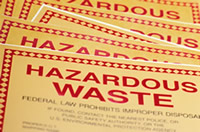 |
The CAA’s Chemical Accident Prevention Program requires that any facility that has listed substances above threshold quantities in any single process prepare a Risk Management Plan (RMP). The listed substances contain 77 toxic chemicals with thresholds ranging from 500 pounds (lb) to 20,000 lb and 63 flammable substances with a threshold quantity of 10,000 lb. The lists of these chemicals are found at 40 CFR 68.130.
General Duty Clause
However, even if a facility does not have a listed substance above the threshold limit or has reconfigured or taken an enforceable limit to avoid having to submit an RMP, a facility may still have responsibilities. If you own or operate a stationary source that produces, processes, handles, or stores any listed substance or other EHS, you are required to identify hazards that may result from the release of these chemicals. This requirement is known as the General Duty Clause.
While the CAA states that no liability or basis for suit resulting from a release is created by this requirement, the General Duty Clause clearly implies the need for you to carefully look at the processes at your facility and take steps to reduce the amount and effects of an accidental release.
Forget expensive calls to lawyers and consultants. With Enviro.BLR.com, you get instant access, 24/7. Try it out today and get the 2015 EHS Salary Guide, absolutely free. Download Now.
Okay, So What Chemicals Do You Need to Worry About?
Here’s the catch. There is no specific list of substances subject to the general duty provisions. The general duty provisions apply to owners and operators of all stationary sources that store or manufacture any EHSs. There is no single list of EHSs. However, we do know that EHSs include the list of regulated substances for facilities required to prepare an RMP (40 CFR 68.130) and EHSs that require reporting under the Emergency Planning and Community Right-to-Know Act regulations (40 CFR 355, Appendices A and B).
To further muddle the issue (or provide guidance—depending on how you look at it), a Senate report on the CAA amendments provides criteria that may be used to determine if a substance is extremely hazardous. The report indicates that an “extremely hazardous substance” is “any substance that causes death or serious injury because of its acute toxic effect or as a result of an explosion or fire, or that would cause substantial property damage by blast, fire, corrosion, or other reaction.” So, the long and the short of it is that it is up to you to determine what chemicals at your facility are EHSs.
Everything You Need for Environmental Compliance
Enviro.BLR.com puts everything you need at your fingertips, including practical RCRA, CAA, CWA, hazardous waste regulatory analysis and activity, news, and compliance tools. Try it at no cost or risk and get a FREE report.
3 Steps to Identify EHSs
Again, while facilities that have processes that use a listed substance above the threshold limit must prepare RMPs, there are no requirements for processes that use an EHS below the threshold levels. At a minimum level, though, you must:
- Step 1: Identify all hazardous chemicals used or produced at the facility. As we said, this includes more than the listed chemicals.
- Step 2: Identify the hazards associated with the chemicals through a process hazard analysis (PHA) using appropriate hazard assessment and techniques. This could include modeling, risk assessment, or engineering calculations to determine the distance a toxic chemical can travel and still be lethal. The PHA should give you the following information:
- The hazards associated with each extremely hazardous substance
- The potential release scenarios from the process
- The potential impact of releases on the public and the environment
- An analysis of whether the impacts are realistic, accurate, and correct
- Step 3: Review and revise PHAs:
- Periodically,
- After any release incident, and
- After process or material changes.
Beyond these 3 steps to identify EHSs, you should take additional steps to:
- Design and maintain a safe facility for processes that involve hazardous chemicals.
- Take appropriate measures to prevent releases and minimize the consequences of any accidental release that may occur.
